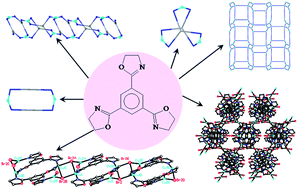Metal–organic frameworks with oxazoline-containing tripodal ligand: structure changes via reaction medium and metal-to-ligand ratio†
Abstract
Six new

* Corresponding authors
a
Coordination Chemistry Institute, State Key Laboratory of Coordination Chemistry, School of Chemistry and Chemical Engineering, Nanjing National Laboratory of Microstructure, Nanjing University, Nanjing, China
E-mail:
sunwy@nju.edu.cn
b Department of Applied Chemistry, College of Chemical and Environmental Engineering, Shandong University of Science and Technology, Qingdao, China
c Department of Macromolecular Science, Graduate School of Science, Osaka University, Toyonaka, Osaka, Japan
d Department of Chemistry, The Scripps Research Institute, La Jolla, CA, USA
Six new

 Please wait while we load your content...
Something went wrong. Try again?
Please wait while we load your content...
Something went wrong. Try again?
Y. Huang, Z. Shen, X. Zhou, T. Okamura, Z. Su, J. Fan, W. Sun, J. Yu and N. Ueyama, CrystEngComm, 2010, 12, 4328 DOI: 10.1039/C002874F
To request permission to reproduce material from this article, please go to the Copyright Clearance Center request page.
If you are an author contributing to an RSC publication, you do not need to request permission provided correct acknowledgement is given.
If you are the author of this article, you do not need to request permission to reproduce figures and diagrams provided correct acknowledgement is given. If you want to reproduce the whole article in a third-party publication (excluding your thesis/dissertation for which permission is not required) please go to the Copyright Clearance Center request page.
Read more about how to correctly acknowledge RSC content.
 Fetching data from CrossRef.
Fetching data from CrossRef.
This may take some time to load.
Loading related content
